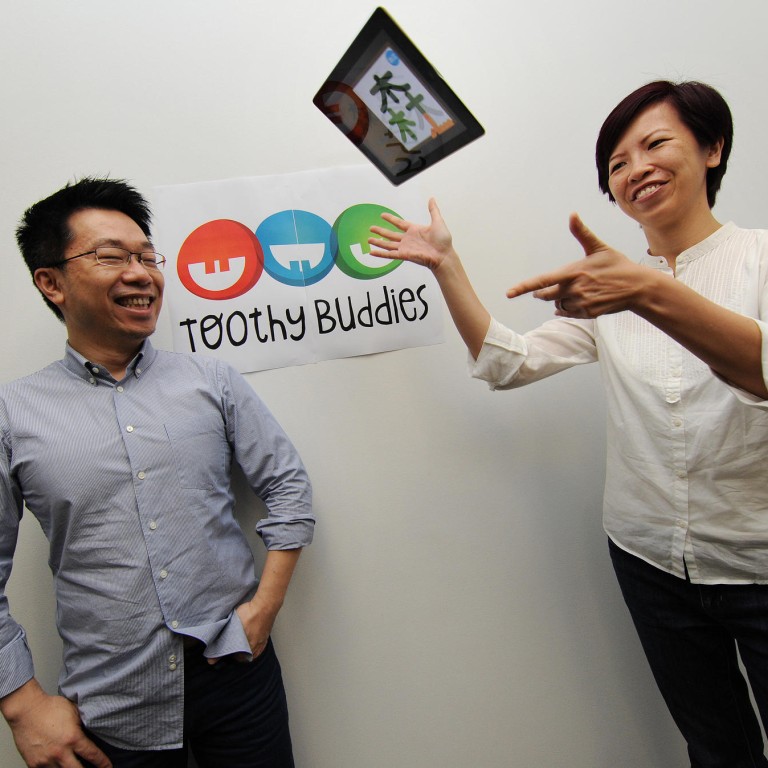
Apps for learning Chinese writing popular with local Hong Kong and expatriate kids
App tested on Chinese and English-speaking children
When digital marketing specialists Venus Lee Lan-kiu and Royce Lee Yat-pui created their Chinese-language learning app last year, their first thought was to test the beta version on a focus group made up of local Chinese children.
But a chance encounter with an English-speaking boy showed them their digital learning tool had far greater potential than they realised.
The boy had been taking part in a session for another product, but the partners decided to also show him their new app, My Chinese Copybook: Elementary Class.
"Without much instruction, the child began to write, and was able to pick up four to five Chinese characters in a short time. His mum [an expatriate] thought it was really amazing," recalls Venus.
That was when the two Lees (no relation) realised that their app could benefit expatriates who want to pick up the language as well as Chinese learners. Before long, they had incorporated English instructions in the app.
The pair set up education apps developer Aedify in 2011, after their digital marketing firm was bought by another company. The partners decided the challenge lay in education.
They researched which digital educational products had succeeded overseas, and sought advice from teachers and principals in Hong Kong. Focus groups with local parents and children also played a part.
This resulted in a series of educational apps for tablets under the Toothy Buddies brand. The first, Carnival of Animals, uses a musical suite by Camille Saint-Saens to introduce children to concepts like pitch and rhythm through interactive, animal-based stories.
The second, Write Dance, adapts a programme created in the West to introduce Chinese handwriting using music.
My Chinese Copybook, the third app, focuses on teaching children how to write Chinese characters, including the correct stroke order and the spatial arrangement.
Released in March, the paid version quickly rose to the top of Hong Kong's iTunes app chart in the education category, and it remains a recommended app. "We hope to bring happiness to children when they learn with our apps. We believe learning should neither be painful nor a struggle," Venus says.
The app is interactive, and aims to give feedback without discouraging young users.

For example, if the young user fails follow the correct stroke order - an important part of writing Chinese characters - the app simply won't let them proceed to the next step. It doesn't allow users to do it incorrectly, and inform them later they were wrong.
As soon as each character is completed, a corresponding graphic appears. If the child writes a character for "cow" that is thinner than it is supposed to be, a picture will appear showing a skinny cow which has a protruding ribcage.
This humorous approach, says Royce, will give young users a good laugh, while suggesting how they could improve their writing next time without discouraging them.
Expatriate parents are finding it useful, he says. "Because the app is not especially challenging, they can let their children play with it. So they will be more inclined to learn Chinese."
The app has also been well-received among Chinese families who have moved overseas, he adds.
Because the app uses use a curriculum based on that drawn up by the Education Bureau, families can easily use it to help their children catch up with the language of their home country.
Expats and overseas Chinese families may be happy that their children are picking up at least some Chinese-language skills, but Royce thinks families in Hong Kong typically strive for excellence.
He stresses that children shouldn't be forced to write too early - a common obsession in Asian families. "There are three reasons why children can't get it right: the lack of muscle control, faulty stroke order and weak spatial arrangement."
Before children hold a pen, parents should first address their visual awareness for words.
Adopting the traditional Chinese practice of requiring young learners to be able to recognise and write a number of characters, as well as deliver pleasing, upright penmanship, can be dispiriting for youngsters when they have not developed the muscle control to use a pen.
That's why they released the Write Dance app before coming up with their writing-learning app, Royce says. It helps parents to first train their children in areas such as how to read a sentence the Chinese way.
"Spatial training is vital for kids to learn how to write Chinese. We want parents to know that writing is not only a mechanical training," notes Royce.
The Aedify founders take pains to emphasise that their apps are not intended to replace formal learning, but rather serve as an aid to it.
"We're not trying squash interaction between teachers and students in the classroom, or between parents and their kids. We want it to be a facilitator," Venus says.
The idea is to better prepare youngsters for the challenges they will face in the classroom. Subsequent apps such as My Chinese Copybook enable them to learn the basics of writing. This entails using their fingers on the touch screen to make various strokes, and combining them into a character.
Earlier this month, the team followed up with the release of Chinese Letter Academy, an upgrade of the Copybook app which incorporates feedback from parents by expanding the character library, and adding a dictation function.
The duo say it is among the top-ranked educational apps for children in the iTunes store in several Asian markets, including Hong Kong, Malaysia, Philippines, Singapore, Taiwan, and Thailand.

